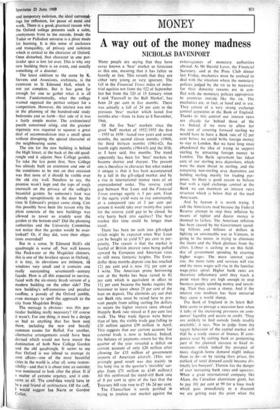Fools rush in ...
ARCHITECTURE STEPHEN GARDINER
Oxford always makes me think of Lewis Carroll. It was under a large tree in the bean's garden at Christ Church that he found the rabbit hole that Alice went down in pursuit of the White Rabbit, and the arches that lead to the glimpses of quad- rangles and bright green grass (particularly when the sun is shining) are like the key- hole through which Alice saw all those biight flowers and lovely fountains.
These mysterious secret gardens and magic spaces are as much the essence of Oxford as they were the inspiration of Carroll's book. A stranger, caught in the appalling daily traffic jam or swallowed up by the crowds, could very easily pass through the city without realising that any- thing very special was happening. He would have to explore: most of the wonderful buildings are hidden behind huge walls off back streets and lanes. Expansion in such a setting, is almost impossible. The rules of secrecy have to be kept if the character of the city is to be protected. The purpose of the college quadrangle, like that of a monastery, is absolute privacy
and temporary isolation, the ideal surroug4- ings for reflection, for peace of mind and
work. There is a good; practical reason why
the Oxford college presents such a calm, anonymous front to the outside. Inside the Tudor or Palladian universe is a place made for learning. It is this sense of enclosure and tranquillity, of privacy and isolation which is critical to the character of Oxford. Once disturbed, that character in one par- ticular spot is lost for ever. This is why any new building there is an event, and usually something of a disaster.
The latest addition to the scene by K. Stevens and Associates, architects, is the extension to St Edmund Hall, which is not yet complete. But it has gone fat enough for one to gather what it is all about. Fundamentally, what the college wanted supplied the perfect subject for a competition. However, the interest was not in the planning of the hundred-odd study bedrooms and so forth—that side of it was a fairly simple matter. The architectural puzzle concerned siting, and the greatest ingenuity was required to squeeze a great deal of accommodation into a small space without disrupting the special character of the neighbouring scene.
The site for the new building is behind the High Street, at the back of the old quad- rangle and it adjoins New College garden.
To take the last point first, New College has already built an extension and one of the conditions to be met on that occasion was that none of it should be visible over the old city wall. Needless to say, the promise wasn't kept and the tops of ro9fs encroach on the privacy of the college's beautiful garden. So someone's foot was already surreptitiously in the door by the time St Edmund's project came along. Can this possibly have been the reason why the plain concrete of the new buildings was allowed to tower so crudely over the garden at the bottom end? Did the planning authorities and the University Committee not notice that the garden would be over- looked? Or, if they did, were their objec- tions overruled?
But in a sense, St Edmund Hall's old quadrangle is worse off. Not well known like Peckwater or the Magdalen cloisters, this is one of the loveliest spaces in Oxford.; it is tiny, its elevations are intimate, it windows very small and it contains one really outstanding seventeenth - century facade. How is all this expected to survive, faced with the six-storey brash version of f modern building on the other side? The new building's self-conscious and peculiar roofline, a parody of the Oxford jumble, even manages to spoil the approach to the city from Magdalen Bridge.
The message is obvious: was this par- ticular building really necessary? Of course it wasn't. For one thing, it must be a design, as bad as anything that has been seen there, including the new and beastly common rooms for Balliol. For another, alternative arrangements could have been devised which would not have meant the domination of both New College Garden and the old quadrangle. It seems to me that Oxford is too inbred to manage its own affairs—one of the most beautiful cities in the world is, after all, some respon- sibility—and that it is about time an outsider was nominated to look after the place. It is a matter of extreme urgency, and it con- cerns us all. The candidate would have to be a real friend of architecture. Off the cuff, I would suggest Ian Nairn or Gordon Cullen.







































 Previous page
Previous page